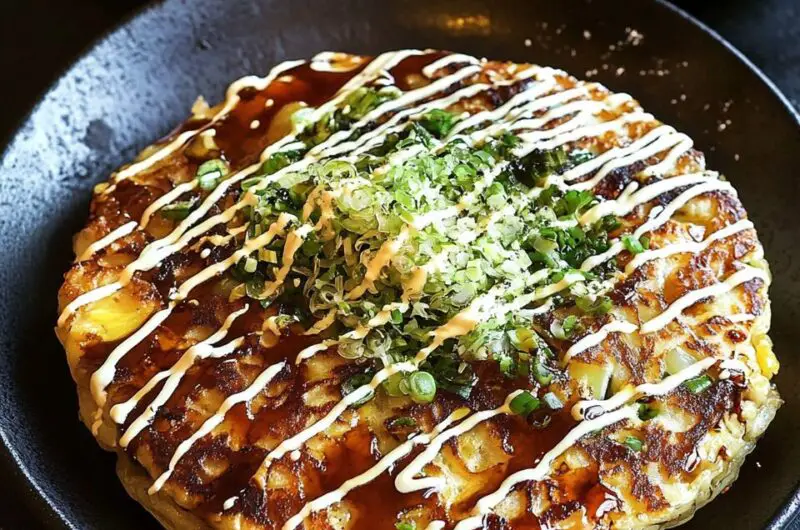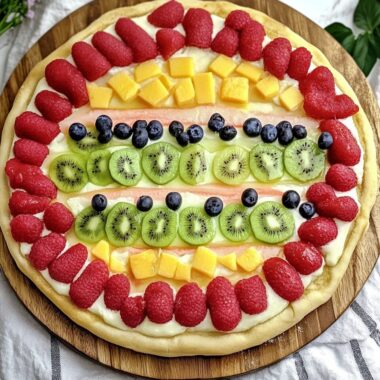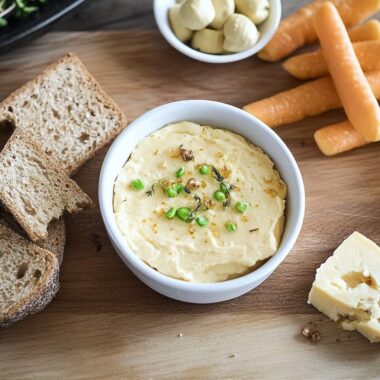Okonomiyaki is a beloved Japanese street food that combines crispy edges, soft cabbage, and rich umami flavors. Originating from Osaka, this dish is a delicious and customizable savory pancake, often topped with okonomiyaki sauce, Kewpie mayonnaise, and dancing bonito flakes. The name “Okonomiyaki” means “grilled as you like it,” making it the perfect dish to experiment with! This easy homemade version captures the essence of authentic Okonomiyaki, balancing the smokiness of bacon, the slight sweetness of cabbage, and the tangy creaminess of Japanese mayo. Whether you’re a Japanese cuisine lover or new to it, this dish will bring the flavors of Osaka right to your kitchen in just 20 minutes!
Full Recipe:
Ingredients:
- 4 slices bacon (or thinly sliced pork belly)
- ⅔ cup all-purpose flour
- 2 tbsp cornstarch
- ½ cup warm water
- 1 tsp dashi powder (dissolved in warm water, or substitute with chicken/vegetable stock)
- 3 eggs
- ¼ head cabbage (finely shredded)
- 1-2 green onions (sliced, half for batter, half for garnish)
- ½ cup canned corn
- 1 tbsp vegetable oil (for cooking)
Toppings:
- 2 tbsp Kewpie mayonnaise
- 2 tbsp okonomiyaki sauce (store-bought or homemade)
- 1 tsp dried seaweed flakes (aonori)
- 1 tsp bonito flakes (katsuobushi)
Directions:
- Cook the bacon in a pan until crispy, then set aside. No need for oil as the bacon releases its own fat.
- In a small jug, whisk together eggs and dashi stock.
- In a large bowl, combine flour and cornstarch, then pour in the egg-dashi mixture. Stir until smooth.
- Add shredded cabbage, half the green onions, cooked bacon, and corn into the batter. Mix gently to coat all ingredients evenly without overmixing.
- Heat a large frying pan over medium heat, add vegetable oil, and scoop batter into the pan, shaping it into a round pancake (about 4 inches wide).
- Cook for 3-4 minutes on each side until golden brown and cooked through.
- Transfer to a plate and drizzle with Kewpie mayonnaise and okonomiyaki sauce.
- Sprinkle with dried seaweed flakes, bonito flakes, and remaining green onions. Serve immediately.
Prep Time: 10 minutes | Cooking Time: 10 minutes | Total Time: 20 minutes
Calories: 320 kcal | Servings: 2 servings
The History of Okonomiyaki
Although Okonomiyaki is now considered a signature dish of Osaka, its origins can be traced back centuries to the Edo period (1603-1868). A similar dish called “Funoyaki” was popular at Buddhist temples and consisted of a simple pancake-like base made with flour and water, which was often enjoyed as a snack.
During the Meiji era (1868-1912), another dish called “Monjayaki” emerged in the Tokyo area. This dish had a thinner, more liquid batter compared to Okonomiyaki and was cooked directly on an iron plate (teppan), much like modern Okonomiyaki.
However, it was during World War II that Okonomiyaki truly evolved into the dish we recognize today. Due to food shortages, rice became scarce, and people turned to wheat-based recipes. Cabbage, which was widely available, became a primary ingredient, and people began adding whatever protein and seasonings they could find. This led to the dish being named “Okonomiyaki” – meaning “grilled as you like it”.
Osaka is credited with popularizing Kansai-style Okonomiyaki, while Hiroshima developed its own unique layered version. Since then, Okonomiyaki has become a favorite at home, in specialty restaurants, and at street food stalls across Japan.
Regional Variations of Okonomiyaki
While Osaka-style Okonomiyaki is the most well-known, different regions of Japan have developed their own interpretations of the dish:
1. Osaka-Style Okonomiyaki (Kansai-Style)
This is the most common version, where all ingredients flour, eggs, cabbage, dashi, and additional toppings are mixed into a batter and then pan-fried. The pancake is then topped with Okonomiyaki sauce, Japanese mayonnaise, dried seaweed (aonori), and bonito flakes (katsuobushi), which dance when placed over the hot pancake due to the rising heat.
2. Hiroshima-Style Okonomiyaki
Unlike Osaka-style, the Hiroshima variation is layered rather than mixed. The batter is spread thinly on the pan, followed by layers of cabbage, bean sprouts, pork belly, and yakisoba noodles. A fried egg is often added on top. This version is slightly more complex to make but offers a different texture and experience.
3. Tokyo-Style Monjayaki
Monjayaki is a thinner, runnier version of Okonomiyaki and is particularly popular in Tokyo’s Tsukishima district. The batter contains more liquid, resulting in a gooey consistency when cooked. Unlike Okonomiyaki, Monjayaki is eaten directly from the griddle using a small spatula.
4. Hiroshima Okonomiyaki with Oysters
Hiroshima is famous for its fresh oysters, and some local Okonomiyaki stalls incorporate grilled oysters into the layered pancake for a richer, seafood-based flavor.
5. Modern Okonomiyaki (Modan-Yaki)
This version includes yaki soba (fried noodles) inside the batter, making it a heartier and more filling meal.
6. Negiyaki (Green Onion Pancake)
A thinner and lighter variation, Negiyaki is made with a batter similar to Okonomiyaki but focuses on using large amounts of green onions instead of cabbage. It is usually served with soy sauce instead of Okonomiyaki sauce.
The Cultural Significance of Okonomiyaki
Okonomiyaki is more than just a meal it is a social dining experience in Japan. Many Okonomiyaki restaurants have tables equipped with a built-in teppan (hot griddle), allowing customers to cook their own pancakes. This makes dining interactive and fun, as friends and family gather to mix, cook, and share the experience together.
This dish is also a symbol of Osaka’s friendly and down-to-earth food culture. Unlike the refined sushi or kaiseki meals, Okonomiyaki is a comfort dish that is affordable, accessible, and packed with flavor.
Additionally, because the dish is customizable, it has found popularity outside of Japan. Many international chefs have taken inspiration from Okonomiyaki, creating fusion versions with ingredients like cheese, kimchi, or even Western-style bacon and cheddar.
Why You Should Try Okonomiyaki at Home
1. Easy to Make
Despite its bold flavors, Okonomiyaki is surprisingly easy to prepare at home. The batter comes together in minutes, and the toppings can be adjusted based on what you have in your kitchen.
2. Budget-Friendly
Okonomiyaki relies on simple and affordable ingredients like cabbage, eggs, and flour. Even with the addition of pork belly or shrimp, it remains a cost-effective meal.
3. Highly Customizable
From vegetarian versions to spicy kimchi-infused pancakes, Okonomiyaki allows you to experiment with different flavors and textures. You can make it gluten-free by using rice flour or explore seafood variations with shrimp or squid.
4. A Crowd-Pleaser
Whether you’re cooking for family, friends, or a dinner party, Okonomiyaki is a dish that impresses. The sizzling pancake, topped with drizzles of mayonnaise and dancing bonito flakes, is a treat for both the eyes and the taste buds.
5. Fun Cooking Experience
The process of making Okonomiyaki mixing the batter, flipping the pancake, and decorating it with toppings makes it an interactive and enjoyable cooking experience.
Conclusion:
Okonomiyaki is a dish that represents Japanese comfort food at its best. It has a rich history, diverse regional styles, and an undeniable ability to bring people together over a delicious, hearty meal. Whether you enjoy the classic Osaka-style or experiment with your own toppings, this dish is one that welcomes creativity and personalization.
If you’ve never tried making Okonomiyaki at home, now is the perfect time to start. With a few simple ingredients and a hot pan, you can bring the flavors of Japan right into your kitchen. So why not give it a try today and discover why Okonomiyaki is loved by so many around the world?








